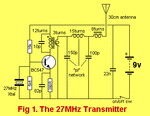samy555
Full Member level 4

Hi
I have some questions about the following circuit:

Thank you very much
I have some questions about the following circuit:

- Is it a common base oscillator?
- If the center frequency of the tank is 27MHz, does this mean that the crystal operated at its fundamental frequency?
- If I made the tank frequency = 81MHz, does this mean that the crystal will operate at its 3ed tone?
- In fact I have a 27.175 MHz crystal, should I have to change the tank values to oscillate at 27.175 MHz?
Thank you very much
Last edited:


